
LOADING ...
In response to evolving domestic opinion, eMedals Inc has made the conscious decision to remove the presentation of German Third Reich historical artifacts from our online catalogue. For three decades, eMedals Inc has made an effort to preserve history in all its forms. As historians and researchers, we have managed sensitive articles and materials with the greatest of care and respect for their past and present social context. We acknowledge the growing sentiments put forth by the Canadian public and have taken proactive actions to address this opinion.
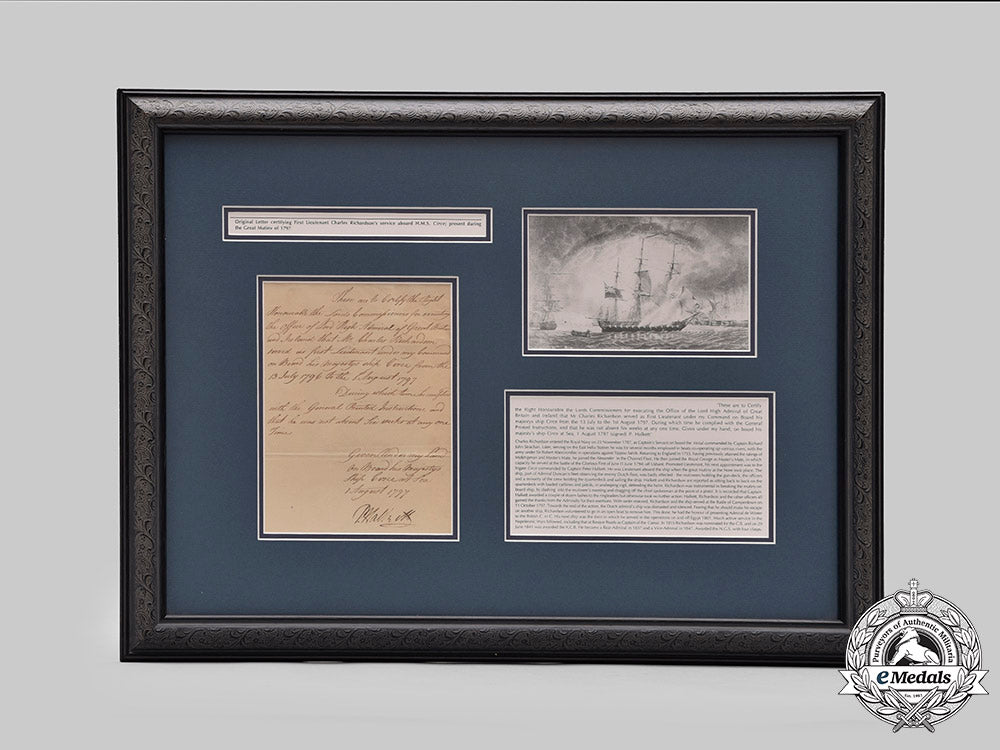
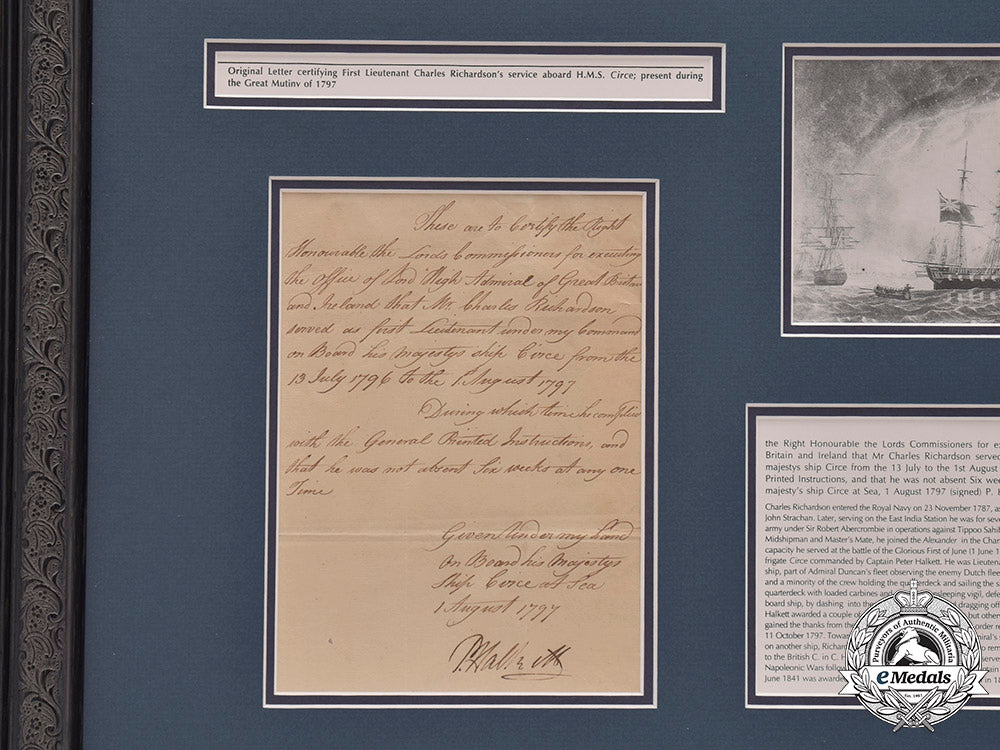
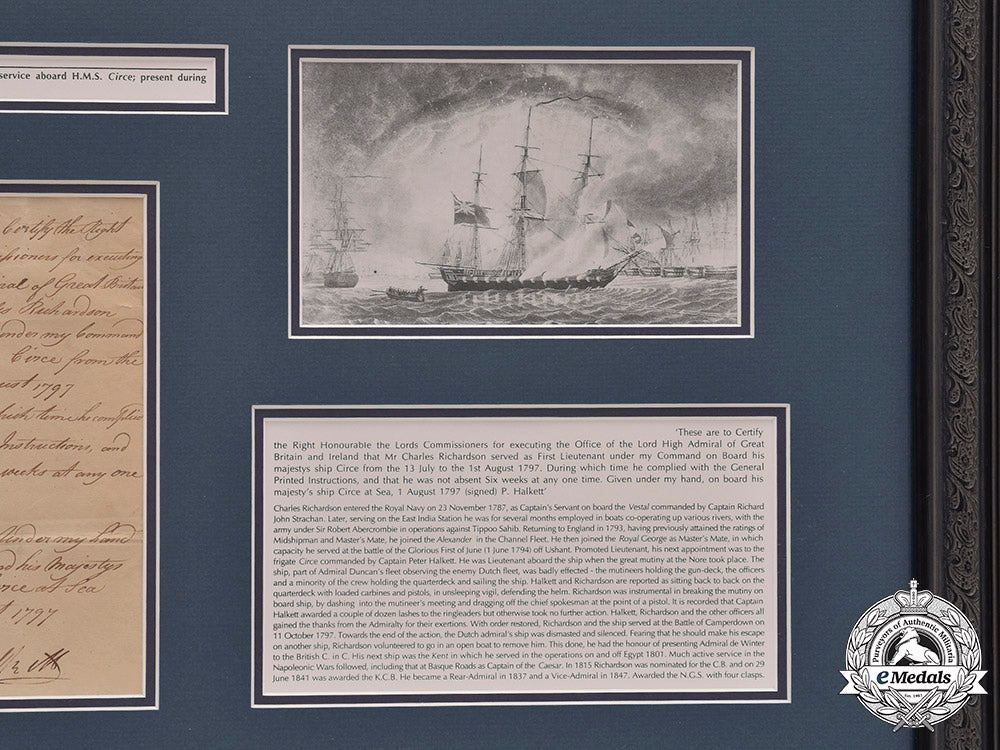
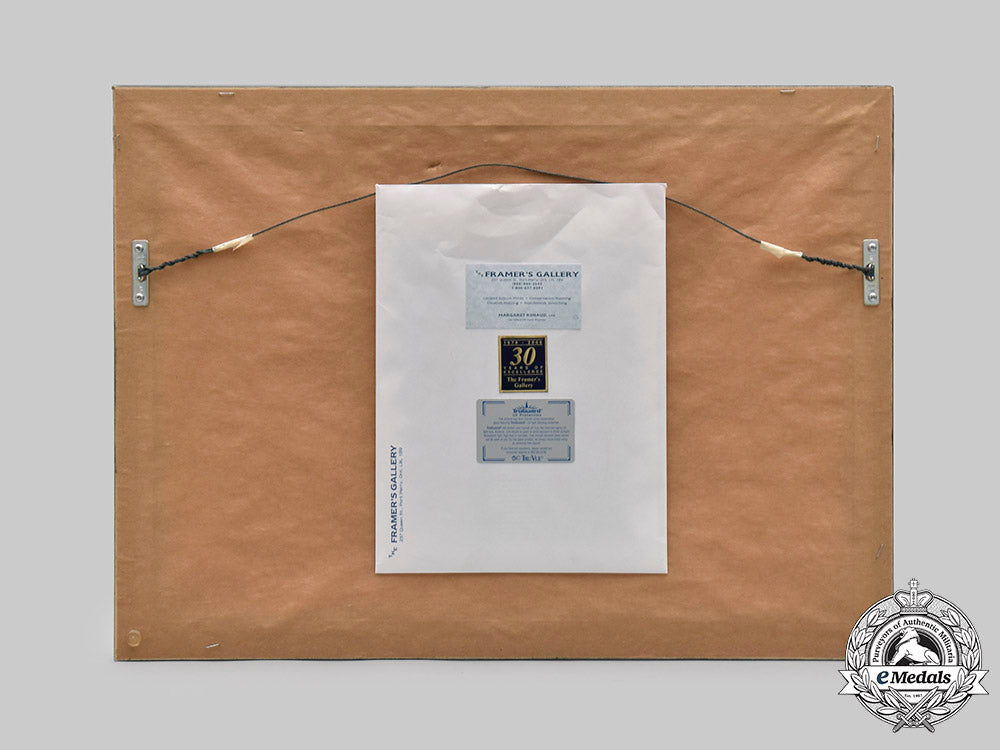
United Kingdom. A Letter Certifying First-Lieutenant Charles Richardson's Service Aboard Hms Circe, Great Mutiny Of 1797
United Kingdom. A Letter Certifying First-Lieutenant Charles Richardson's Service Aboard Hms Circe, Great Mutiny Of 1797
SKU: ITEM: GB7351
Current Bid:
Your Max Bid:
Bid History:
Time Remaining:
Couldn't load pickup availability
Shipping Details
Shipping Details
eMedals offers rapid domestic and international shipping. Orders received prior to 12:00pm (EST) will be shipped on the same business day.* Orders placed on Canadian Federal holidays will be dispatched the subsequent business day. Courier tracking numbers are provided for all shipments. All items purchased from eMedals can be returned for a full monetary refund or merchandise credit, providing the criteria presented in our Terms & Conditions are met. *Please note that the addition of a COA may impact dispatch time.
Shipping Details
eMedals offers rapid domestic and international shipping. Orders received prior to 12:00pm (EST) will be shipped on the same business day.* Orders placed on Canadian Federal holidays will be dispatched the subsequent business day. Courier tracking numbers are provided for all shipments. All items purchased from eMedals can be returned for a full monetary refund or merchandise credit, providing the criteria presented in our Terms & Conditions are met. *Please note that the addition of a COA may impact dispatch time.
Description
Description
Letter in handwritten black ink on a light brown paper, inscribed "These are to Certify the Right Honourable the Lords Commissioners for executing the Office of the Lord High Admiral of Great Britain and Ireland that Mr. Charles Richardson served as First Lieutenant under my Command on Board his majesty's ship Circe from the 13 July to the 1st August 1797. / During which time he complied with the General Printed Instructions, and that he was not absent Six weeks at any one Time. / Given under my hand on Board his Majesty's ship Circe at Sea 1 August 1797" and signed "P. Halkett" (Captain Peter Halkett, later Admiral Sir Peter Halkett, 6th Baronet), measuring approximately 150 mm (w) x 200 mm (h), fold marks. Accompanied by an illustration of the 28-gun Enterprise-class sixth-rate frigate HMS Circe, a heading, along with a block of explanatory text, each of the four pieces matted, under glass and contained within a 605 mm (w) x 450 mm (h) gray-finished wooden frame, kraft paper backer with a paper pocket placed on it with research papers enclosed, plus a wire strung across horizontally for wall hanging. Extremely fine.
Footnote No. 1: Charles Richardson entered the Royal Navy on November 23, 1787, as Captain's Servant on board the 28-gun Enterprise-class sixth-rate frigate HMS Vessel commanded by Captain Richard John Strachan. Later, serving on the East India Station, he was employed for severalmonths in boats co-operating up various rivers with the Army, under Sir Robert Abercrombie, in operations against Tippoo Sahib (AKA Tipu Sultan). Returning to England in 1793, having previously attained the ratings of Midshipman and Master's Mate, he joined the 74-gun third-rate Alfred-class ship of the line HMS Alexander in the Channel Fleet. He then joined the 100-gun first rate ship of the line HMS Royal George as Master's Mate, in which capacity he served at the Battle of the Glorious First of June (June 1, 1794) off Ushant. Promoted to the rank of Lieutenant, his next appointment was to the 28-gun Enterprise-class sixth-rate frigate HMS Circe commanded by Captain Peter Halkett. Richardson was a First-Lieutenant aboard the ship when the great mutiny at the Nore took place. The ship, part of Admiral Duncan's fleet observing the enemy Dutch fleet, was badly affected - the mutineers holding the gun-deck, the officers and a minority of the crew holding the quarterdeck and sailing the ship. Captain Halkett and First-Lieutenant Richardson are reported as having sat back-to-back on the quarterdeck with loaded carbines and pistols, in unsleeping vigil, defending the helm. Richardson was instrumental in breaking the mutiny on board ship, by dashing into the mutineers meeting and dragging off the chief spokesman at the point of a pistol. It is recorded that Captain Halkett awarded a couple of dozen lashes to the ringleaders but otherwise, took no further action. Halkett, Richardson and the other officers all gained the thanks from the Admiralty for their exertions. With order restored, Richardson and the ship served at the Battle of Camperdown on October 11, 1797. Towards the end of the action, the Dutch admiral's ship was dismasted and silenced. Fearing that he should make his escape on another ship, Richardson volunteered to go in an open boat to remove him. This done, he had the honour of presenting Admiral de Winter to the British Commander-in-Chief. His next ship was the 74-gun third-rate ship of the line HMS Kent, in which he served in the operations on and off Egypt in 1801. Extensive service during the Napoleonic Wars followed, including that at Basque Roads as Captain of the 80-gun third rate ship of the line HMS Caesar. In 1815, Richardson was nominated for the Companion of the Order of the Bath (CB), and on June 29, 1841, he was awarded the Knights Commander of the Order of the Bath (KCB). Richardson would go on to become a Rear-Admiral on January 10, 1837 and a Vice-Admiral on December 17, 1847. In addition, he was the recipient of the Naval General Service Medal with four clasps.
Footnote No. 2: Admiral Sir Peter Halkett, 6th Baronet, was born in 1765, the second son of Sir John Halkett, the 4th Halkett Baronet of Pitfirrane in Fife, Scotland. At a young age, Halkett entered the Royal Navy and as a Lieutenant achieved his first command, that of the tiny sloop HMS Placentia in 1789. By 1793, he was serving on HMS Syren, which conveyed the Duke of York to the Netherlands for service in the French Revolutionary Wars. During the campaign, Halkett served in gunboats assisting the Dutch garrison during the Siege of Williamstadt and impressed the Duke with his activity, being rewarded with a promotion to Post Captain and an expensive medal from the Prince of Orange. On his return to Britain in October 1794, Captain Halkett was given command of the frigate HMS Circe in the North Sea. In May 1797, due to the exertions of her officers, HMS Circe's crew did not join the Spithead and Nore mutinies. Halkett received orders to put out to sea, which he did, leaving Yarmouth and sailing, together with some hired armed vessels to protect merchant trade. He continued to cruise until his supplies were almost exhausted and then he sailed HMS Circe into the Humber, a large tidal estuary on the east coast of Northern England. He then waited at Hull until the mutiny was over. Captain Halkett received the "thanks of the Admiralty and the freedom of the town of Hull for the conduct of his ship during the alarming period." Later that year, HMS Circe acted as a signal frigate for the fleet under Admiral Adam Duncan that destroyed a Dutch fleet at the Battle of Camperdown. In the aftermath of the battle, Halkett moved to the larger frigate HMS Apollo, but his ship was lost on the Dutch coast, Halkett and his men rescued by a Prussian ship. At the subsequent court martial, Halkett was cleared of any blame in the loss of his ship and he was given command of a new frigate, also named HMS Apollo. In HMS Apollo, Halkett sailed for the West Indies and remained there for two years, capturing a number of French and Spanish vessels, including privateers. He returned to Britain in 1802 and subsequently joined the ship of the line HMS Ganges. At the Second Battle of Copenhagen in 1807 Ganges carried commodore Richard Goodwin Keats' flag. Halkett remained in command of Ganges until 1812, when he was made a Rear-Admiral. Halkett did not see a lot of subsequent high command, although he remained in service during the Napoleonic Wars, stationed at Portsmouth aboard HMS Gladiator. After the war, Halkett remained in service, becoming a Vice-Admiral in 1821 and a full Admiral in 1837. In 1837, he inherited his father's baronetcy from his brother. In 1836, he got his only major seagoing command, when he spent two years as Commander-in-Chief of the North America and West Indies Station, before returning to Britain. Halkett died at home in Pitfirrane in October 1839. His wife Elizabeth, whom he had married in 1802, had died in 1814, but Halkett was survived by his son John, who inherited the baronetcy.
Shipping Footnote: Please note that there will be an additional shipping charge during or post time of purchase.
Description
Letter in handwritten black ink on a light brown paper, inscribed "These are to Certify the Right Honourable the Lords Commissioners for executing the Office of the Lord High Admiral of Great Britain and Ireland that Mr. Charles Richardson served as First Lieutenant under my Command on Board his majesty's ship Circe from the 13 July to the 1st August 1797. / During which time he complied with the General Printed Instructions, and that he was not absent Six weeks at any one Time. / Given under my hand on Board his Majesty's ship Circe at Sea 1 August 1797" and signed "P. Halkett" (Captain Peter Halkett, later Admiral Sir Peter Halkett, 6th Baronet), measuring approximately 150 mm (w) x 200 mm (h), fold marks. Accompanied by an illustration of the 28-gun Enterprise-class sixth-rate frigate HMS Circe, a heading, along with a block of explanatory text, each of the four pieces matted, under glass and contained within a 605 mm (w) x 450 mm (h) gray-finished wooden frame, kraft paper backer with a paper pocket placed on it with research papers enclosed, plus a wire strung across horizontally for wall hanging. Extremely fine.
Footnote No. 1: Charles Richardson entered the Royal Navy on November 23, 1787, as Captain's Servant on board the 28-gun Enterprise-class sixth-rate frigate HMS Vessel commanded by Captain Richard John Strachan. Later, serving on the East India Station, he was employed for severalmonths in boats co-operating up various rivers with the Army, under Sir Robert Abercrombie, in operations against Tippoo Sahib (AKA Tipu Sultan). Returning to England in 1793, having previously attained the ratings of Midshipman and Master's Mate, he joined the 74-gun third-rate Alfred-class ship of the line HMS Alexander in the Channel Fleet. He then joined the 100-gun first rate ship of the line HMS Royal George as Master's Mate, in which capacity he served at the Battle of the Glorious First of June (June 1, 1794) off Ushant. Promoted to the rank of Lieutenant, his next appointment was to the 28-gun Enterprise-class sixth-rate frigate HMS Circe commanded by Captain Peter Halkett. Richardson was a First-Lieutenant aboard the ship when the great mutiny at the Nore took place. The ship, part of Admiral Duncan's fleet observing the enemy Dutch fleet, was badly affected - the mutineers holding the gun-deck, the officers and a minority of the crew holding the quarterdeck and sailing the ship. Captain Halkett and First-Lieutenant Richardson are reported as having sat back-to-back on the quarterdeck with loaded carbines and pistols, in unsleeping vigil, defending the helm. Richardson was instrumental in breaking the mutiny on board ship, by dashing into the mutineers meeting and dragging off the chief spokesman at the point of a pistol. It is recorded that Captain Halkett awarded a couple of dozen lashes to the ringleaders but otherwise, took no further action. Halkett, Richardson and the other officers all gained the thanks from the Admiralty for their exertions. With order restored, Richardson and the ship served at the Battle of Camperdown on October 11, 1797. Towards the end of the action, the Dutch admiral's ship was dismasted and silenced. Fearing that he should make his escape on another ship, Richardson volunteered to go in an open boat to remove him. This done, he had the honour of presenting Admiral de Winter to the British Commander-in-Chief. His next ship was the 74-gun third-rate ship of the line HMS Kent, in which he served in the operations on and off Egypt in 1801. Extensive service during the Napoleonic Wars followed, including that at Basque Roads as Captain of the 80-gun third rate ship of the line HMS Caesar. In 1815, Richardson was nominated for the Companion of the Order of the Bath (CB), and on June 29, 1841, he was awarded the Knights Commander of the Order of the Bath (KCB). Richardson would go on to become a Rear-Admiral on January 10, 1837 and a Vice-Admiral on December 17, 1847. In addition, he was the recipient of the Naval General Service Medal with four clasps.
Footnote No. 2: Admiral Sir Peter Halkett, 6th Baronet, was born in 1765, the second son of Sir John Halkett, the 4th Halkett Baronet of Pitfirrane in Fife, Scotland. At a young age, Halkett entered the Royal Navy and as a Lieutenant achieved his first command, that of the tiny sloop HMS Placentia in 1789. By 1793, he was serving on HMS Syren, which conveyed the Duke of York to the Netherlands for service in the French Revolutionary Wars. During the campaign, Halkett served in gunboats assisting the Dutch garrison during the Siege of Williamstadt and impressed the Duke with his activity, being rewarded with a promotion to Post Captain and an expensive medal from the Prince of Orange. On his return to Britain in October 1794, Captain Halkett was given command of the frigate HMS Circe in the North Sea. In May 1797, due to the exertions of her officers, HMS Circe's crew did not join the Spithead and Nore mutinies. Halkett received orders to put out to sea, which he did, leaving Yarmouth and sailing, together with some hired armed vessels to protect merchant trade. He continued to cruise until his supplies were almost exhausted and then he sailed HMS Circe into the Humber, a large tidal estuary on the east coast of Northern England. He then waited at Hull until the mutiny was over. Captain Halkett received the "thanks of the Admiralty and the freedom of the town of Hull for the conduct of his ship during the alarming period." Later that year, HMS Circe acted as a signal frigate for the fleet under Admiral Adam Duncan that destroyed a Dutch fleet at the Battle of Camperdown. In the aftermath of the battle, Halkett moved to the larger frigate HMS Apollo, but his ship was lost on the Dutch coast, Halkett and his men rescued by a Prussian ship. At the subsequent court martial, Halkett was cleared of any blame in the loss of his ship and he was given command of a new frigate, also named HMS Apollo. In HMS Apollo, Halkett sailed for the West Indies and remained there for two years, capturing a number of French and Spanish vessels, including privateers. He returned to Britain in 1802 and subsequently joined the ship of the line HMS Ganges. At the Second Battle of Copenhagen in 1807 Ganges carried commodore Richard Goodwin Keats' flag. Halkett remained in command of Ganges until 1812, when he was made a Rear-Admiral. Halkett did not see a lot of subsequent high command, although he remained in service during the Napoleonic Wars, stationed at Portsmouth aboard HMS Gladiator. After the war, Halkett remained in service, becoming a Vice-Admiral in 1821 and a full Admiral in 1837. In 1837, he inherited his father's baronetcy from his brother. In 1836, he got his only major seagoing command, when he spent two years as Commander-in-Chief of the North America and West Indies Station, before returning to Britain. Halkett died at home in Pitfirrane in October 1839. His wife Elizabeth, whom he had married in 1802, had died in 1814, but Halkett was survived by his son John, who inherited the baronetcy.
Shipping Footnote: Please note that there will be an additional shipping charge during or post time of purchase.



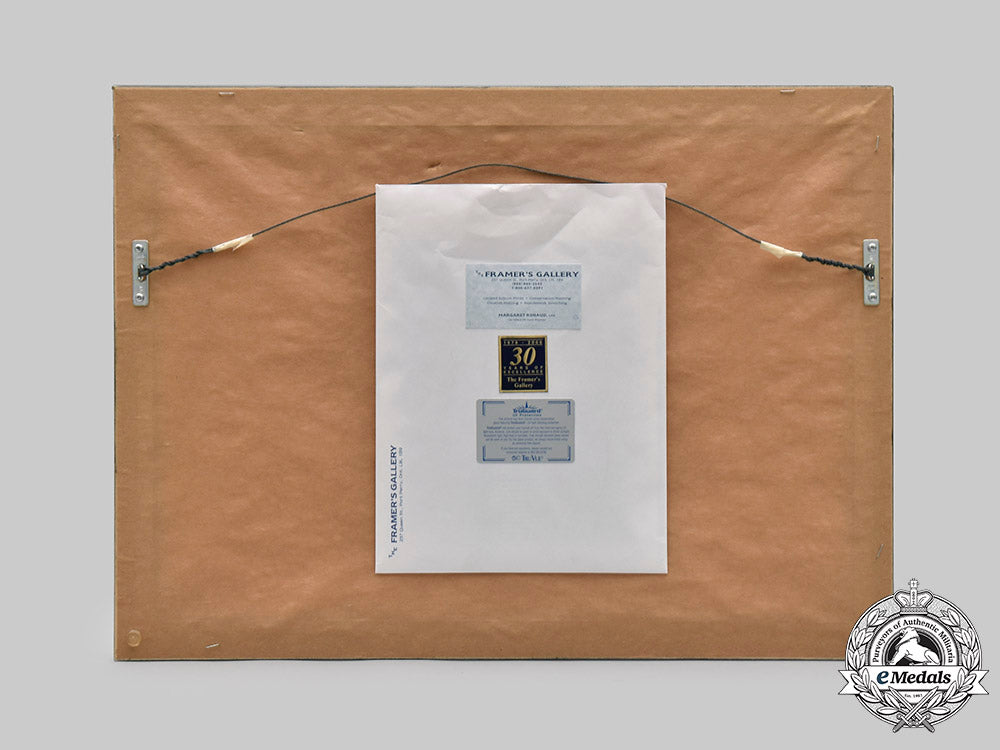
You May Also Like
Germany, HJ. A 1938 National Trade Competition Victor’s Badge, Gold Grade in Case, By Gustav Brehmer
G60096
Italy, Republic. An Order of Merit of the Italian Republic, Grand Cross Set by Johnson, 1970
EU23677
Spain, Franco Period. An Order of Civil Merit, Grand Cross Set
EU23731
Russia, Imperial. An Order of St. Anne, II Class in Gold
EU23720
Austria, Imperial. An Order of the Iron Crown, III Class in Gold, by Rothe, c.1900
EU23723
-
Germany, HJ. A 1938 National Trade Competition Victor’s Badge, Gold Grade in Case, By Gustav Brehmer
G60096
Add to CartRegular price $3,950 USDRegular price $0 USD Sale price $3,950 USDUnit price / per -
Italy, Republic. An Order of Merit of the Italian Republic, Grand Cross Set by Johnson, 1970
EU23677
Add to CartRegular price $950 USDRegular price $0 USD Sale price $950 USDUnit price / per -
Spain, Franco Period. An Order of Civil Merit, Grand Cross Set
EU23731
Add to CartRegular price $600 USDRegular price $0 USD Sale price $600 USDUnit price / per -
Russia, Imperial. An Order of St. Anne, II Class in Gold
EU23720
Add to CartRegular price $2,950 USDRegular price $0 USD Sale price $2,950 USDUnit price / per -
Austria, Imperial. An Order of the Iron Crown, III Class in Gold, by Rothe, c.1900
EU23723
Add to CartRegular price $3,950 USDRegular price $0 USD Sale price $3,950 USDUnit price / per
Do you have a similar item you are interested in selling?
Please complete the form and our client care representatives will contact you.
Sell Item












